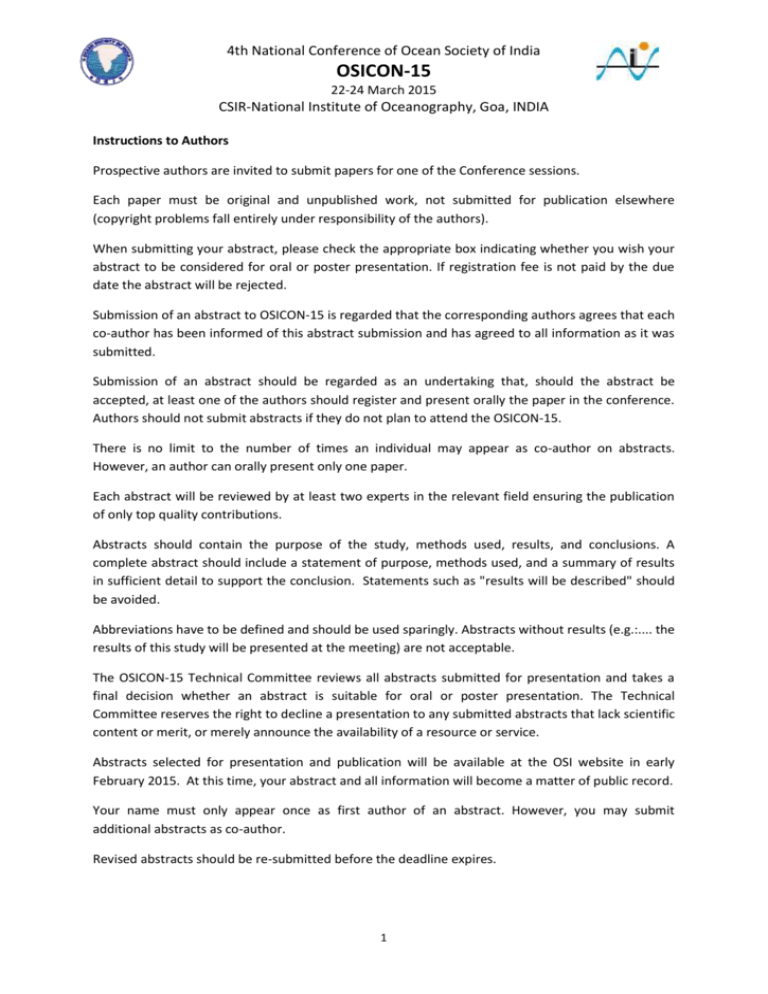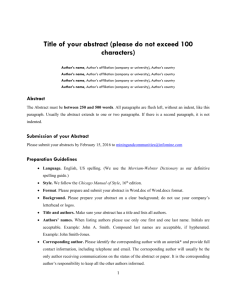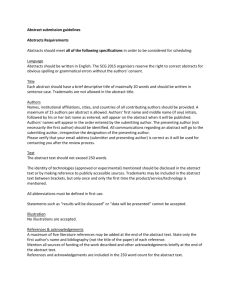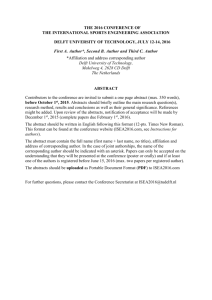Instructions for Authors
advertisement

4th National Conference of Ocean Society of India OSICON-15 22-24 March 2015 CSIR-National Institute of Oceanography, Goa, INDIA Instructions to Authors Prospective authors are invited to submit papers for one of the Conference sessions. Each paper must be original and unpublished work, not submitted for publication elsewhere (copyright problems fall entirely under responsibility of the authors). When submitting your abstract, please check the appropriate box indicating whether you wish your abstract to be considered for oral or poster presentation. If registration fee is not paid by the due date the abstract will be rejected. Submission of an abstract to OSICON-15 is regarded that the corresponding authors agrees that each co-author has been informed of this abstract submission and has agreed to all information as it was submitted. Submission of an abstract should be regarded as an undertaking that, should the abstract be accepted, at least one of the authors should register and present orally the paper in the conference. Authors should not submit abstracts if they do not plan to attend the OSICON-15. There is no limit to the number of times an individual may appear as co-author on abstracts. However, an author can orally present only one paper. Each abstract will be reviewed by at least two experts in the relevant field ensuring the publication of only top quality contributions. Abstracts should contain the purpose of the study, methods used, results, and conclusions. A complete abstract should include a statement of purpose, methods used, and a summary of results in sufficient detail to support the conclusion. Statements such as "results will be described" should be avoided. Abbreviations have to be defined and should be used sparingly. Abstracts without results (e.g.:.... the results of this study will be presented at the meeting) are not acceptable. The OSICON-15 Technical Committee reviews all abstracts submitted for presentation and takes a final decision whether an abstract is suitable for oral or poster presentation. The Technical Committee reserves the right to decline a presentation to any submitted abstracts that lack scientific content or merit, or merely announce the availability of a resource or service. Abstracts selected for presentation and publication will be available at the OSI website in early February 2015. At this time, your abstract and all information will become a matter of public record. Your name must only appear once as first author of an abstract. However, you may submit additional abstracts as co-author. Revised abstracts should be re-submitted before the deadline expires. 1 4th National Conference of Ocean Society of India OSICON-15 22-24 March 2015 CSIR-National Institute of Oceanography, Goa, INDIA Inquiries about the status of the abstract after submission will not be answered till the final decision is taken. Authors will be informed by e-mail as soon as the final decision has been made. A template of the Abstract is on page 3. 2 4th National Conference of Ocean Society of India OSICON-15 22-24 March 2015 CSIR-National Institute of Oceanography, Goa, INDIA TITLE OF THE PAPER SHOULD BE PLACED HERE WITH CALIBRI 14 POINT BOLD FONT ALL CAPS AND CENTRED A. V. First Author1*, W.E. Second Author2, Third Author3 1 Affiliation of first author with address; *corresponding.author.email@address.here 2 Affiliation of second author with address 3 Affiliation of third author with address The abstract should not exceed 2 (two pages) including tables, references [Basco, 1983], etc. The font of the abstract should be 12 points of Calibri typed in single line spacing. It is suggested to use this template and overwrite the text of the abstract. Alternately, the text can be typed in a notepad, copy it and paste here so that the font of the abstract text is maintained. The equations should be numbered serially with the equation typed in Microsoft Equation Editor and number placed to the end as shown below: du u u u .... dt t x (1) The figures should be centred and numbered serially and should be inserted in line with the text. Authors should avoid copying the figures from another source and pasting it into the abstract which could create problems in editing. References: Basco, D. R. (1983), Surfzone currents, Coastal Engineering, 7(4), 331-355. 3




